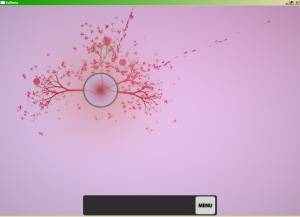Eufloria: Wrapping Up
Posting really late this time: I managed to breeze through the remainder of Eufloria on Sunday afternoon and evening. Some days, writing is just hard.
I said before that there was never a good reason to zoom in in Eufloria. This isn’t quite true. There are two reasons do to is. First, taking a closer look at enemy seedlings can give you information about their stats. The stats — Energy, Strength, and Speed, all determined by the properties of the asteroid where they sprouted — determine a seedling’s shape and size. This isn’t very useful, though; although having better stats doubtless helps, battles are generally won through overwhelming numbers, and you don’t need to zoom in to see those.
The other reason is that you have to zoom in order to reposition your view. There’s no way to just scroll around the battlefield directly; all you can do is zoom into a spot near the edge and then zoom out from there. A peculiar UI choice, and not the only one — to some degree, this game is a showcase for experiments. Consider the way you send seedlings from one asteroid to another. You can send the asteroid’s entire population by left-dragging from source to destination, or you can right-click the source repeatedly to increment a counter of how many you want to send, one seedling per click. Neither of these options is ideal when you want to split up your hundred-strong armada into two groups to pursue different routes. The solution here is to left-drag out only a little way — the targeting interface that shows the limits of where you can travel to also shows a circle around the asteroid you started at, and within the bound of that circle, your mouse-dragging acts like a radial slider for selecting anything up to 100% of the seedlings there. It was only well into the game that I started taking advantage of this, partly because I didn’t really understand it. The game could stand better documentation (or any at all), but then, I probably wouldn’t have read it anyway.
It turns out that there was only one more game element to be introduced after my last post: the flowers that I planted to let my defensive trees grow orbital defenses could alternately, past a certain level, be used to enhance seedling production. Beyond that, the remaining levels produce variety through the scenarios. One level plays with scarcity, in the form of asteroids that could only support one tree, or none at all. One is a timed survival challenge, one is an escort mission. Several of them have plot triggers when you explore particular asteroids — for example, one level has a particularly large one in the opposite corner from where you start, obviously serving as the enemy home base, until you actually reach it and discover that it’s just the beginning of a larger empire, which immediately attacks you. (This is where the limitations on scrolling around become important: they prevent you from knowing the true extents of the level.) Occasionally, the triggers are outmoded by the time you reach them: I recall getting a pop-up describing how the planet I had just explored had fallen victim to the “gray plague” (a side consisting of senselessly aggressive zombie seedlings), when in fact another computer-controlled enemy had already driven it out.
In short, most of the game is spent on the sort of thing I can imagine happening in any other RTS. But in a way, I think that’s the point: that your basic RTS tactics don’t have to be coupled to conventional military imagery. You can put them in a world of pastel colors and gentle ambient music and it works just as well.
 Comments(2)
Comments(2)